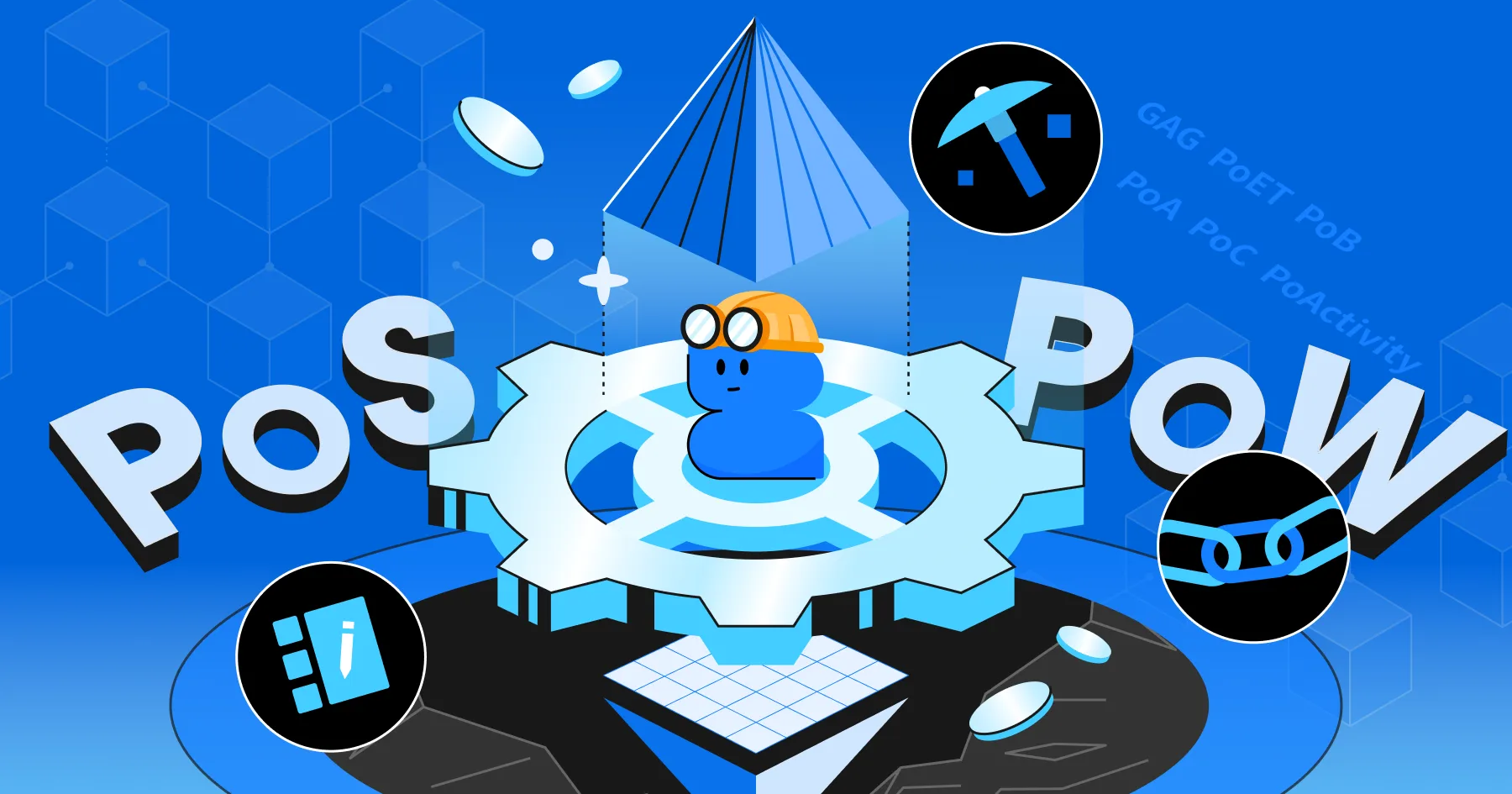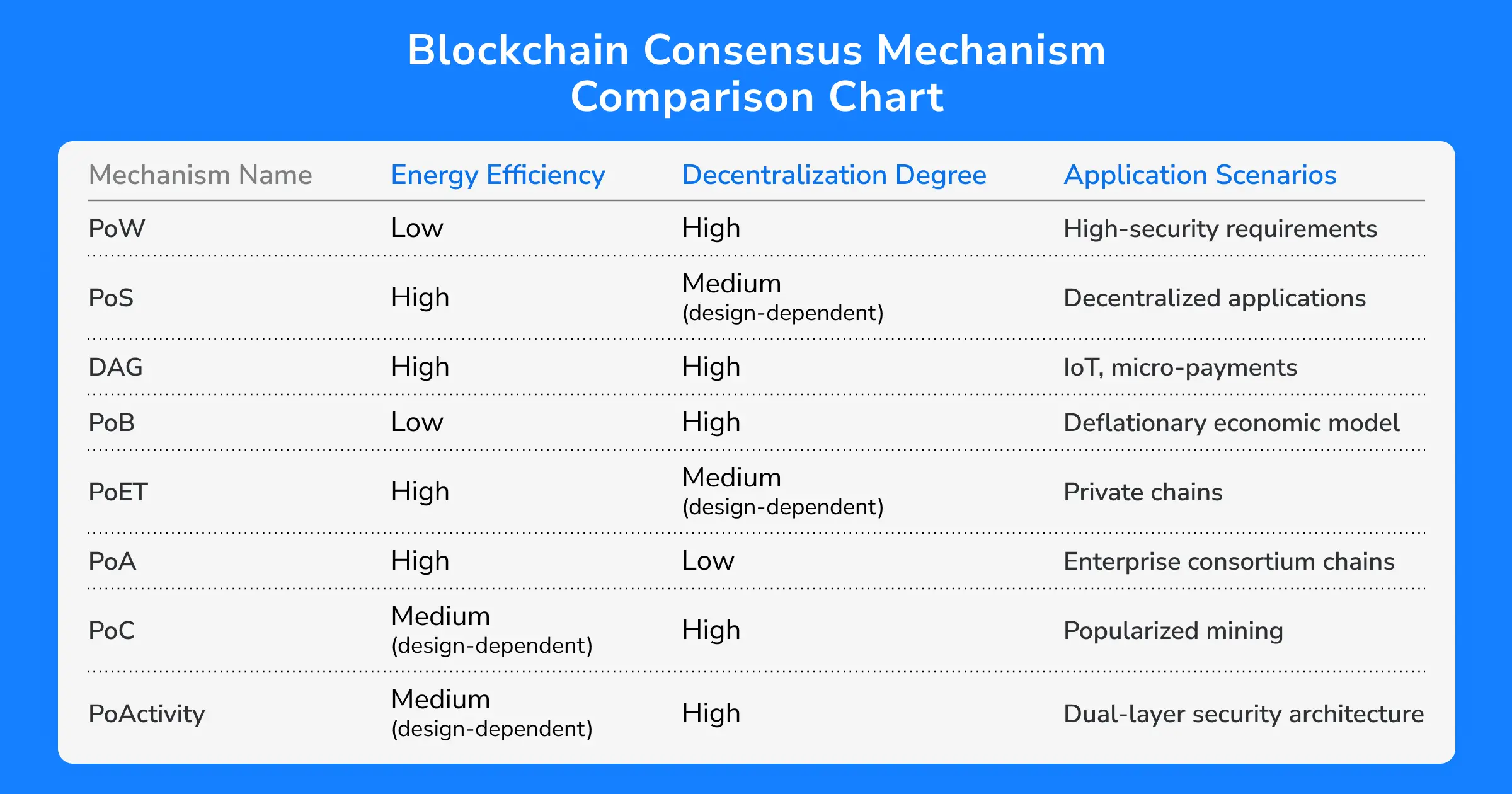Comprehensive Guide to Blockchain Consensus Mechanisms: PoW, PoS, DAG & More

Why Is the Consensus Mechanism the Heart of Blockchain?
The defining feature of blockchain is decentralization—no single entity controls the network. But without a central authority, how do all nodes agree on which transactions are valid? The answer is: consensus mechanisms.
The Role of a Consensus Mechanism:
• Creates a unified ledger across distributed nodes
• Prevents double-spending and data tampering
• Determines who gets to add blocks to the chain
• Ensures secure, stable, and trusted operations
Imagine a group of people trying to keep a shared ledger without a judge or supervisor—everyone must verify each other’s records. They need an agreed set of rules to reach consensus. That’s exactly what a consensus mechanism provides.
Basic Principles of Consensus Mechanisms
The goal of a consensus mechanism is to allow decentralized nodes to agree on the state of transactions—even in the absence of trust.
The Basic Process:
1. Transaction Broadcast – A user initiates a transaction, which is propagated across the network.
Node Verification – Each node verifies the transaction's validity based on the consensus rules (e.g., checking digital signatures, balances).
2. Consensus Achievement – Once a sufficient number of nodes agree (e.g., 2/3 majority), the transaction is included in a new block.
3. Blockchain Write – The block is linked to the previous one using cryptographic methods, forming an immutable chain.
Core Goals:
• Build a trustworthy ledger
• Prevent malicious actors from cheating
• Protect transaction data from tampering
Most consensus algorithms include a fault tolerance design—typically Byzantine Fault Tolerance (BFT)—which allows the system to function even if some nodes are malicious or faulty. For example, Bitcoin requires over 51% of network computing power to rewrite history, making it extremely hard to tamper with as long as honest miners hold the majority of power. Ultimately, consensus mechanisms use cryptography and game theory to incentivize good behavior and discourage cheating—building a trustless yet reliable system.
Analysis of the Four Most Common Consensus Mechanisms
1. Proof of Work (PoW)
PoW is the oldest and most widely adopted consensus model, first introduced by Bitcoin. All participating nodes (miners) compete to solve complex mathematical puzzles using computational power. The first to solve it earns the right to record the block and receives a reward—this process is called "mining."
Examples: Bitcoin, Litecoin
Pros:
• High security and resistance to attacks
• Fully decentralized
Cons:
• Extremely energy-intensive
• Low throughput (TPS) and slow block times
• Risk of mining pool centralization
2. Proof of Stake (PoS)
In PoS, validators are chosen based on the amount of cryptocurrency they stake (lock up) in the network. The more tokens you stake, the higher your chance of being selected to validate and add the next block.
Examples: Ethereum 2.0, Cardano, Solana
Pros:
• Very energy-efficient (Ethereum reduced energy use by 99.95% after switching to PoS)
• Faster block times
Cons:
• Potential for “the rich get richer” dynamics
• Reduced liquidity due to staking lock-up
3. DAG (Directed Acyclic Graph)
DAGs differ from traditional linear blockchains. Transactions reference and validate one another directly, forming a graph-like structure rather than a chain. This allows for parallel processing and is seen as a promising solution for scalability.
Examples: IOTA, Nano
Pros:
• High concurrency and scalability
• Ideal for IoT and micropayments
Cons:
• Complex architecture
• Often requires centralized "coordinators" for network stability
• Immature ecosystem with limited real-world testing
4. Delegated Proof of Stake (DPoS)
DPoS is an enhanced version of PoS, introduced by Dan Larimer in BitShares. Instead of all stakers validating blocks, users vote to elect a small number of "delegates" or "witnesses" to perform validation, greatly improving speed and efficiency.
Examples: EOS, TRON, Lisk, Steem
Pros:
• High performance and low latency, suitable for enterprise applications
• Democratic governance through voting
Cons:
• Lower decentralization due to limited validator count
• Risk of delegate monopolies if voter participation is low
5 Other Consensus Mechanisms and Use Cases
1. Proof of Burn (PoB)
In PoB, participants must "burn" (destroy) their coins by sending them to an unspendable address. This represents a commitment to the network and earns them the right to mine or validate blocks.
Examples: Slimcoin, Counterparty (historical)
Pros:
• Energy-efficient, no need for hardware
• Encourages long-term participation through economic commitment
Cons:
• Permanently destroys tokens, making participation expensive
• Wealthy users have an advantage, risking centralization
2. Proof of Elapsed Time (PoET)
PoET uses trusted hardware (e.g., Intel SGX) to randomly assign wait times. Once the wait is over, the node can create a block. It’s designed for permissioned or enterprise blockchains.
Examples: Hyperledger Sawtooth
Pros:
• Extremely low energy consumption
• Equal block production chances for all nodes
Cons:
• Heavily reliant on trusted hardware
• Not suitable for fully decentralized public chains
3. Proof of Authority (PoA – Authority)
PoA relies on a small group of authorized validators with known identities. It is commonly used in consortium or enterprise settings where efficiency and compliance are priorities.
Examples: VeChain, Binance Smart Chain (early version)
Pros:
• Fast block times and low latency
• Suitable for high-frequency business transactions
Cons:
• Highly centralized
• Lacks resistance to censorship or manipulation
4. Proof of Capacity (PoC)
PoC relies on storage space instead of computing power. Participants pre-store data on hard drives and compete based on how much space they’ve allocated.
Examples: Chia, Burstcoin
Pros:
• Energy-efficient
• Accessible to regular users with consumer hardware
Cons:
• High wear on storage devices, risk of e-waste
• Greater space = greater chance of winning, risking centralization
5. Proof of Activity (PoA – Activity)
A hybrid model combining PoW and PoS. PoW miners initiate block creation, while PoS validators finalize them through digital signatures.
Examples: Decred (DCR)
Pros:
• Combines PoW's security with PoS's participation
• Requires control over both hash power and stake to attack
Cons:
• Complex implementation
• Limited adoption and use cases

Future Trends in Consensus Mechanism Evolution
As blockchain technology and its applications expand, consensus mechanisms continue to evolve toward greater efficiency, security, and scalability.
Anticipated Trends:
1. Wider BFT Adoption:
Byzantine Fault Tolerance models are gaining popularity in consortium and next-gen public chains. Future models may combine BFT with staking mechanisms for hybrid consensus solutions.
2. Hybrid and Innovative Models:
To balance speed and security, more projects are adopting multi-consensus strategies (e.g., PoW + PoS, BFT + Staking). These hybrid models offer flexible performance optimization.
3. Green and Sustainable Consensus:
Amid growing criticism of Bitcoin’s energy use and tighter environmental policies, low-energy models like PoS and PoC are becoming mainstream. Some researchers are even exploring AI-based energy optimization or dynamically adjusting consensus based on renewable energy supply.
4. Use-Case-Specific Consensus:
There won’t be a one-size-fits-all solution. Different applications—IoT, supply chain, finance—may benefit from different consensus types (e.g., DAG for IoT, PoA for enterprise chains). Even within a single network, multiple consensus layers may emerge.
As technology advances, we may see the rise of entirely new consensus algorithms—ones we haven’t even imagined yet—that push the boundaries of what decentralized systems can achieve. Just as the vision of blockchain evolves, so too will the engines that power it.
About ZONE Wallet
ZONE Wallet is a blockchain investment gateway designed for Taiwanese users.
It combines full regulatory compliance, cutting-edge security, and TWD transaction support, with a mission of making “every crypto transaction safe and secure.”
Start building your crypto portfolio with ease—today.
Investing in virtual assets carries risks related to price volatility and liquidity. The above content is for reference only and does not constitute any financial advice. Please carefully assess your financial situation before investing and be cautious of potential fraud.






